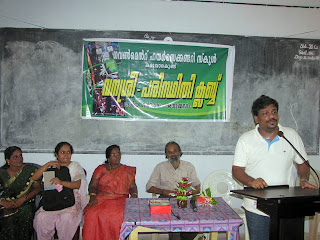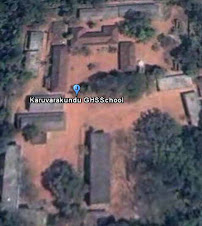Tuesday, July 20, 2010
Tuesday, July 13, 2010
Seminar-Biodiversity Conservation 2010
Seminar on Bio-Diversity
Chief Guests:- 1. S.Sivadas, IFS-Silent Valley Wildlife Warden
2. Dr.Anoop Das, Zoology Lecturer, MES College, Mampad
3. Dhanya, Researcher(House Sparrows)
അറിവല്ല അനുഭവമാണ് പരിസ്ഥിതി വിദ്യാഭ്യാസത്തിന്റെ മൌലിക ഘടകമെന്ന് സൈലന്റ് വാലി ദേശിയ ഉദ്യാനത്തിന്റെ വാര്ടെന് ശ്രീ എസ് .ശിവദാസ് അഭിപ്രായപ്പെട്ടു. കരുവാരകുണ്ട് ഗവ. ഹയര് സെകണ്ടരി സ്കൂളിലെ പരിതിതി ക്ലബ്ബായ വന്ശ്രീയുടെ ആഭിമുഖ്യത്തില് നടക്കുന്ന ജൈവ വര്ഷച്ചരണത്തിന്റെ ഉല്കടണം നിര്വഹിച്ചു സംസാരിക്കുകയായിരുന്നു അദ്ദേഹം. ഭുമിയോടുള്ള കടമ ദൈവിക ബാദ്യതയാണെന്ന് തിരിച്ചറിവും അതിലൂടെ അറിവും അനുഭവവും കടന്നു അനുഭുതിയില് എത്തുകയും വേണം. മരം നട്ടത് കൊണ്ടും പ്ലാസ്റ്റിക് പെറുക്കി മാറ്റിയത് കൊണ്ട് മാത്രം പരിസ്ഥിതി പ്രവര്ത്തനം പൂര്തിയവുന്നില്ലെന്നു അദ്ദേഹം കൂട്ടിച്ചേര്ത്തു. സമരങ്ങളും പ്രതികരണങ്ങള് പോലും ഭാവാത്മക പ്രവര്ത്തനം ആകണം, അദ്ദേഹം പറഞ്ഞു. മമ്പാട് എം. ഇ. എസ്. കോളേജ് ജന്തു ശാസ്ത്ര വിഭാഗം അദ്യാപകന് ഡോ.അനൂപ് ദാസ്, സാലിം അക്ലബ്ബംഗങ്ങള് എല്ലാവരും ജൈവ വൈവിദ്യ പ്രതിഗ്ന ഏറ്റു ചൊല്ലി. ഇന്ന് മുതല് എല്ലാവരും ബോള് പേനക്ക് പകരം മഷി പേന മാത്രമേ ഉപയോഗിക്കുവെന്നും പ്രതിഘ്ന ചെയ്തു. സാലി അലി ഫൌണ്ടാഷനിലെ ശാസ്ത്രഗ്ന ധന്യ എന്നിവര് ജൈവ വൈവിദ്യത്തെ കുറിച്ച് ക്ലാസ്സെടുത്തു. പ്രിന്സിപ്പല് ശ്രീമതി സുമതി ടീച്ചര് അധ്യക്ഷത വഹിച്ചു. വി.എസ്. പൊന്നമ്മ, എസ്.പ്രസാദ്, ഷാജഹാന് എന്നിവര് സംബന്ധിച്ചു. എ.വിനോദ് സ്വാഗതവും മുനവ്വിര് നന്ദിയും പറഞ്ഞു.
various species which are at the brink of extinction. Dhanya madam, who is doing her Doctorate in house sparrows, told that much studies are not done about the house sparrows. Before going for studies, we have to identify its main habitats, a data collection sheet was given to selected students to collect details about the sparrow.
Sunday, July 4, 2010
Beware of dangers of CFL Bulbs
Potentially poisonous
Mercury is key to making compact fluorescent light bulbs (CFLs) efficient. Electricity sent through the lamp, which contains mercury vapor and an inert gas such as argon, zaps the mercury, setting off a reaction that creates light.
The reaction is more efficient at converting power into light, with less residual heat than a normal incandescent bulb.
Each CFL contains about 5 milligrams of mercury, just enough to cover the tip of a ballpoint pen. By contrast, a mercury thermometer contains 500 milligrams of mercury.
The silvery substance can be dangerous even in small quantities, though, because it can be inhaled or absorbed through the skin, and it damages the central nervous system.
Small amounts can also build up in the environment if the bulbs are thrown in the garbage and break or are incinerated.
Mercury can enter the food chain and accumulate, for example, when big fish eat smaller fish that contain mercury, as is already the case with tuna and other large fish.
"The two reasons they'll toss them: they either don't know or they don't care. If we can educate the ones who don't know, we can pressure the ones who don't care."
kea stores have dedicated kiosks where customers can bring their used lights, regardless of where they were purchased, according to an Ikea spokesperson.
As of Feb. 8, 2006, it is actually illegal for California residents to throw CFLs away.
if broken indoors will flood the space with toxic mercury vapors. Mercury is one of the most toxic elements on earth and it affects the nervous system and kidneys , neurotoxin that can cause serious damage to the all the tissues and organs in the body as well as the central nervous system and endocrine system and it disrupts functioning of crucial neurotransmitters in the brain. autism, memory problems, infertility, depression, thyroid disorders, alzheimers, adrenal disorders, anxiety, Parkinson’s and MS to name a few. It is especially toxic to children, pregnant women and small pets.
CFLs emit EMF radiation, EMF radiation has been linked to cancer, neurological disorders, and it plays havoc with diabetics. It's almost like living in a microwave with a living space full of CFLs.
Ron Hui, a Hong Kong professor, chairman of the electronic engineering department and co-author of a recent peer reviewed publication on the environmental impact of CFLs, tells us that each bulb contains “3-5 milligrams of mercury. The safe intake of mercury for a human body is a few micrograms. One milligram is 1,000 micrograms.” However, other studies report that CFL bulbs may contain as much as 30 milligrams of mercury and estimate that they are releasing about two to four tons of mercury into our air each year.
Hui points out that no one wants to talk about the issue that the circuit board of the bulbs, which is where the mercury is implanted, can’t be recycled and there is nowhere for the toxins to go but our air and soil and we are creating a ticking time for our future generations.
Physicians report they are seeing an increase in migraines, headaches and severe skin rashes caused by compact fluorescent light bulbs.
Guidelines for Cleaning Up Broken CFL Bulbs
Suggestions will vary depending on the source, but here are the most common.
§ remove children, pregnant women and pets immediately
(they should not participate in or be present during the clean up process)
(they should not participate in or be present during the clean up process)
§ ventilate the area well
§ open a window and leave the room for at least 15 minutes
§ wear gloves, a mask and safety glasses
§ do not use a sweeper or a broom to clean it up
§ do not turn on your heating or air conditioning system
§ pick up big pieces with your fingers
§ use sticky tape to get small pieces
§ wipe the area with a wet rag
§ place all broken materials collected as well as all materials used in the clean up process in a second sealed plastic bag (air tight) or a screw-top glass jar and remove them from the house.
§ throw everything away that was used in the clean up process, including the rag and gloves.
§ if the break occurs on a carpet, cut that piece of that carpet out and throw it away.
§ wash your hands immediately
§ call your local recycling center to see if they collect CFL bulbs, otherwise put it in the trash.
§ as a preventative measure, it is suggested that compact fluorescent light bulbs should never be used in areas where there is carpeting or in sockets where a breakage is more likely to occur.
Why LED's?
Because LEDs are solid state, they don't break when dropped. LED bulbs contain no mercury and they are about as efficient as CFLs. LEDs can be recycled easily, and the materials re-used. And most important, they have the potential to become even more efficient and less expensive as LED technology improves.
Subscribe to:
Posts (Atom)




